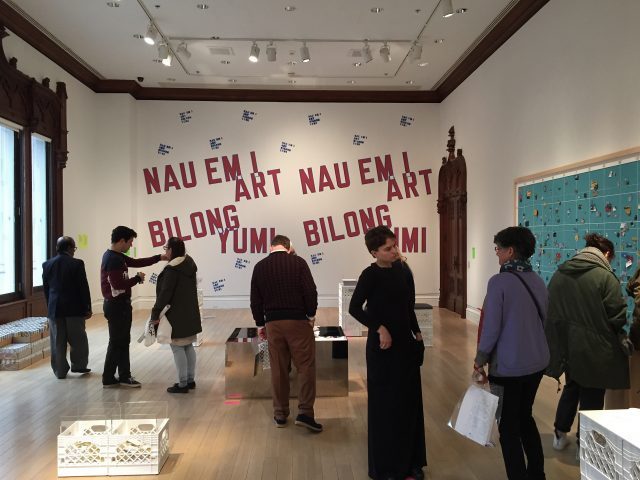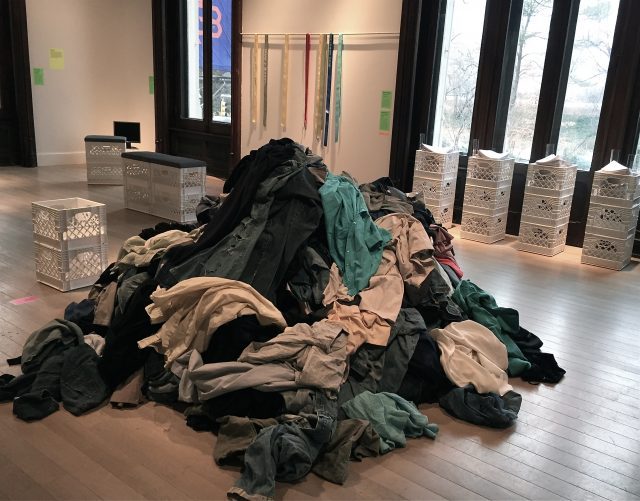
Jewish Museum exhibit gives visitors a chance to go home with actual objets d’art (photo by twi-ny/mdr)
The Jewish Museum
1109 Fifth Ave. at 92nd St.
Thursday – Sunday, $7.50 – $15 (free admission Saturday 11:00 am – 5:45 pm, pay-what-you-wish Thursday 5:00 – 8:00)
212-423-3200
thejewishmuseum.org
“Don’t just look. Touch, take, share,” the Jewish Museum advises about its interactive exhibition “Take Me (I’m Yours),” which continues through Sunday. In 1995, curator Hans Ulrich Obrist and artist Christian Boltanski teamed up at the Serpentine Gallery in London for a show of the same name, in which a dozen artists created works that visitors could literally take home, exploring such ideas as creation, engagement, interactivity, participation, ownership, value, consumerism, and the art market itself. The Jewish Museum show features pieces by forty-two artists and collectives, several from the original Serpentine presentation; a Kickstarter campaign helped fund approximately ten thousand of each work so visitors could add to their own personal art collection. “In principle a work of art has always been reproducible,” Walter Benjamin wrote in his 1935 essay “The Work of Art in the Age of Mechanical Reproduction,” adding, “Even the most perfect reproduction of a work of art is lacking in one element: its presence in time and space, its unique existence at the place where it happens to be.” Andrea Bowers’s “Political Ribbons,” featuring feminist mottos, were taken from the museum and worn by protesters at the recent women’s march on Washington. Boltanski’s “Dispersion” consists of used clothing that is meant to be taken and used; the ever-changing mound evokes Felix Gonzalez-Torres’s nearby “Untitled (USA Today),” edible (and kosher) sugar-free candies that, when taken, not only change the shape of the work as a whole but reference loss, especially poignant since Gonzales-Torres and his partner both died of AIDS in the 1990s. Carsten Höller’s “Pill Clock (Red and White),” a mechanism high in a corner, slowly dispensing edible capsules one by one, and Ian Cheng and Rachel Rose’s untitled container of fortune cookies call into question material possession as visitors decide whether to take the objects home to keep or to just eat them, which is a completely different experience.

“Take Me (I’m Yours)” is filled with items that call into question consumerism, consumption, and the art market itself (photo by twi-ny/mdr)
The concepts of immateriality and ownership are also raised in such pieces as aaajiao’s “Email Trek,” in which the art is an email; Kelly Akashi’s “Cavelike,” a sound installation; Alison Knowles’s “Shoes of Your Choice,” involving audience performance; James Lee Byars’s “Be Quiet,” in which a slow-moving woman in a dark dress approaches people who are talking and silently gives them a small, circular piece of colored paper that says, “Be Quiet”; General Sisters’ “No One Is Disposable” recycled, sustainable toilet paper that declares “I am not illegal”; and Daniel Spoerri’s “Eat Art Happening,” a large-scale skeleton made of nonkosher sugar paste that will be devoured by museumgoers on February 5 in “Everything Must Go,” providing the sweet taste of death on the last day of the exhibition. Other pieces to look out for are Uri Aran’s untitled plaster casts of the tops of takeout coffee lids, Andrea Fraser’s “Preliminary Prospectuses” detailing art as corporate commodity, Gilbert & George’s anarchistic buttons, Yngve Holen’s wearable “Evil Eye” contact lenses, Jonas Mekas’s “With Thanks to Joseph Cornell and Rose Hobart” filmstrip (a museum employee will cut a segment for those who ask), Yoko Ono’s “Air Dispenser” capsules (which cost a quarter), Rirkit Tiravanija’s “Untitled (Form Follows Function or Vice Versa No. Two)” T-shirts, Daniel Joseph Martinez’s “(America) Adopt a Refugee” kit, and Jonathan Horowitz’s “Hillary 16” poster depicting the official portraits of all the presidents — except with Hillary Clinton following Barack Obama. Scattered throughout the exhibition are definitions of such words and phrases as New Materialism, Economy, Market, Gift, Charity, Relics, Immateriality, Relational Aesthetics, Exchange, and Democratization, placing it all in sociopolitical perspective. Perhaps it is all summed up by Lawrence Weiner’s pidgin English installation “NAU EM I ART BILONG YUMI,” which translates as “The art of today belongs to us.” Among the other artists giving away cool stuff are Luis Camnitzer, Maria Eichhorn, Hans-Peter Feldmann, Alex Israel, Rivane Neuenschwander, Martha Rosler, Allen Ruppersberg (paying homage to Gonzalez-Torres), Tino Sehgal, and Haim Steinbach. (Note that some works are not available on Saturday.) You’re likely to go home with a bag filled with goodies, but how many will you keep long-term as you reevaluate their worth over time? However, the experience will never go away; just be sure not to pocket any items throughout the rest of the museum.